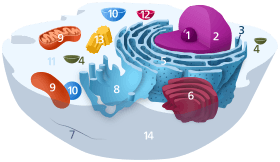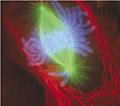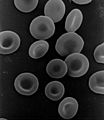Cell nucleus facts for kids



A cell nucleus (plural: cell nuclei) is the part of the cell which contains the genetic code, the DNA. The nucleus is small and round, and it works as the cell's control center. It contains chromosomes which house the DNA. The human body contains billions of cells, most of which have a nucleus. All eukaryote organisms have nuclei in their cells, even the many eukaryotes that are single-celled. Bacteria and Archaea, which are prokaryotes, are single-celled organisms of quite a different type and do not have nuclei. Cell nuclei were first found by Antonie van Leeuwenhoek in the 17th century.
Inside the nucleus there are no membrane-bound sub-compartments. Its contents are not uniform, and a number of sub-nuclear bodies exist, made up of unique proteins, RNA molecules, and particular parts of the chromosomes. The best-known of these is the nucleolus, which is mainly involved in the assembly of ribosomes. After being produced in the nucleolus, ribosomes are exported to the cytoplasm where they translate mRNA into proteins.
When a cell is dividing or preparing to divide, the chromosomes become visible with a light microscope. At other times when the chromosomes are not visible, the nucleolus will be visible.
Contents
Nuclear membrane
Large molecules cannot get through the double-layer nuclear membrane: it is impermeable to them. However, nuclear pores exist. They control the movement of molecules across the membrane. The pores cross both nuclear membranes, providing a channel. The larger molecules are actively transported by carrier proteins, and there is free movement of small molecules and ions. Movement of large molecules such as proteins and RNA through the pores is required for both gene expression and the maintenance of chromosomes.
Nucleolus
Within the nucleus is a structure called a nucleolus. It is made at a nucleolus organizer region (NOR), which is a chromosomal region around which the nucleolus forms. Inside the nucleolus ribosomes are made. These are exported through the nuclear pore complexes to the cytoplasm, where they are work to build proteins and sometimes become attached to the endoplasmic reticulum if they are making membrane proteins.
Images for kids
-
HeLa cells stained for nuclear DNA with the blue fluorescent Hoechst dye. The central and rightmost cell are in interphase, thus their entire nuclei are labeled. On the left, a cell is going through mitosis and its DNA has condensed.
-
A mouse fibroblast nucleus in which DNA is stained blue. The distinct chromosome territories of chromosome 2 (red) and chromosome 9 (green) are stained with fluorescent in situ hybridization.
-
An electron micrograph of a cell nucleus, showing the darkly stained nucleolus
-
Macromolecules, such as RNA and proteins, are actively transported across the nuclear membrane in a process called the Ran-GTP nuclear transport cycle.
-
An image of a newt lung cell stained with fluorescent dyes during metaphase. The mitotic spindle can be seen, stained green, attached to the two sets of chromosomes, stained light blue. All chromosomes but one are already at the metaphase plate.
-
Oldest known depiction of cells and their nuclei by Antonie van Leeuwenhoek, 1719
See also
 In Spanish: Núcleo celular para niños
In Spanish: Núcleo celular para niños








